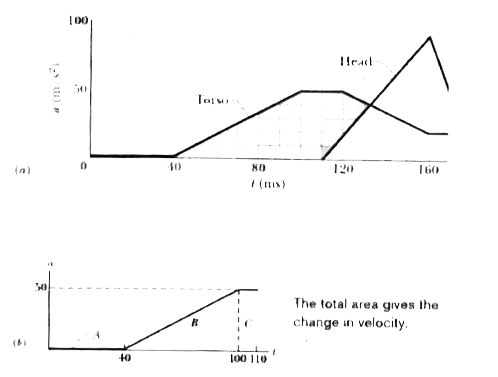"Whiplash injury" commonly occurs in a rear-end collision where a front car is hit from behind by a second car. In the 1970s, researches concluded that the injury was due to the occupant's head being whipped back over the top of the seat as the car was slammed forward. As a result of this finding, head restraints were built into cars, yet neck injuries in rarend collisions continued to occur.
In a recent test to study neck injury in rear-end collisions, a volunteer was strapped to a seat that was then moves abruptly to simulate a collision by a rear car moving at 10.5 km/h. Figure 2-15 a gives the accelerations of the volunteer's torso and head during the collision, which began at time . The torso acceleration was delayed by 40 ms because during that time interval the seat back had to compress against hte volunteer. The head acceleration was delayed by an aditional 70 ms. What was the torso when the head began to accelerate ?
KEY IDEA
We can calculate the torso speed at any time by finding an area on the torso a(t) graph.
Calculations : We know that the initial torso speed is at time , at the start of the " collision." We want the torso speed at time , which is when the head begins to accelerate.
Combining Eqs. 2-27 and 2-28, we can write
( area between acceleration curve and time axis, from to ). (2-31)
For convenience, let us separate the area into three regions ( Fig. 2-15b). From 0 to 40 ms, region A has no area :
.
From 40 ms to 100 ms, region B has the shape of a triangle, with area
From 100 ms to 110 ms, region C has the shape of a rectangle, with area
.
Substituting these values and into Eq. 2-31 gives us
,
or .
Reasoning: When the head is just starting to move forward, the torso already has a speed of 7.2 km/h.
Researchers argue that it is this difference in speeds during the early stage of a rear-end collision that injures the neck. The backward whipping of hte head happens later and could, especially if there is no head restraint, increase the injury.

Topper's Solved these Questions
- MOTION ALONG A STRAIGHT LINEBOOK - RESNICK AND HALLIDAYCHAPTER - MOTION ALONG A STRAIGHT LINEEXERCISE - Checkpoints
5 Videos
- MOTION ALONG A STRAIGHT LINEBOOK - RESNICK AND HALLIDAYCHAPTER - MOTION ALONG A STRAIGHT LINEEXERCISE - PROBLEMS
53 Videos
- MOTION ALONG A STRAIGHT LINEBOOK - RESNICK AND HALLIDAYCHAPTER - MOTION ALONG A STRAIGHT LINEEXERCISE - SAMPLE PROBLEM 2.09
1 Videos
- MAGNETIC FORCEBOOK - RESNICK AND HALLIDAYCHAPTER - MAGNETIC FORCEEXERCISE - Practice Questions (Integer type )
7 Videos
- MOTION IN TWO AND THREE DIMENSIONSBOOK - RESNICK AND HALLIDAYCHAPTER - MOTION IN TWO AND THREE DIMENSIONSEXERCISE - PRACTICE QUESTIONS (MATRIX-MATCH)
10 Videos
Similar Questions
Knowledge Check
The mirror used for the head light of a car is
Aa spherical concaveBb planeCc cylindricalDd parabolic concaveA car will hold 2 in the front seat and 1 in the rear seat. If among 6 persons 2 can drive, then the number of ways in which the car can be filled is:
A10B40C30D20
A car at rest is struck from the rear by a second car. The injuries incurred by the two drivers are of distinctly different character Explain.
View SolutionIn a collision between two cars, which would you expect to be more damaging to the occupants, if the cars collide expect to be more damaging to the occupants, if the cars collide and ramain together, or if the two rebound backward ? Explain.
View SolutionIs head light of a car or an air plane polarized ?
View SolutionA large truck and a car, both moving with a velocity of magnitude v, have a head- on collision and both of them come to a halt after that. If the collision lasts for 1s:
(a) Which vehicle experiences the greater force of impact?
(b) Which vehicle experiences the greater change in momentum?
(c) Which vehicle experiences the greater acceleration?
(d)Why is the car likely to suffer more damage than the truck?
View SolutionA car will hold 2 in the front seat and 1 in the rear seat. If among 6 persons 2 can drive, then the number of ways in which the car can be filled is:
View SolutionIn the head lights of a car, what kind of mirror are used? What is the use of mirror in the car head lights? Explain.
View Solution
